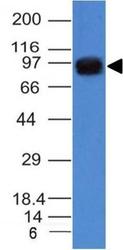Antibody data
- Antibody Data
- Antigen structure
- References [0]
- Comments [0]
- Validations
- Western blot [1]
Submit
Validation data
Reference
Comment
Report error
- Product number
- NBP2-36444-0.1mg - Provider product page

- Provider
- Novus Biologicals
- Product name
- Mouse Monoclonal UACA Antibody
- Antibody type
- Monoclonal
- Description
- Protein A or G purified. This monoclonal antibody is part of a new panel of reagents, which recognizes subcellular organelles or compartments of human cells. These markers may be useful in identification of these organelles in cells, tissues, and biochemical preparations. It recognizes an antigen associated with the nuclear membrane expressed in human cells. It can be used to stain the nuclear membrane in cell or tissue preparations and can be used as a marker of the nuclear membrane in subcellular fractions. It produces a ring pattern around the nucleus of cells of normal and malignant cells and may be used to stain the nuclear membrane of cells in fixed or frozen tissue sections. It can be used with paraformaldehyde fixed frozen tissue or cell preparations and formalin fixed, paraffin-embedded tissue sections.,The nuclear envelope (also known as the perinuclear envelope, nuclear membrane, nucleolemma or karyotheca) is the double membrane of the nucleus that encloses genetic material in eukaryotic cells. It separates the contents of the nucleus (DNA in particular) from the cytosol (cytoplasm). Numerous nuclear pores are present on the nuclear envelope to facilitate and regulate the exchange of materials (for example, proteins and RNA) between the nucleus and the cytoplasm. The space between the two membranes that make up the nuclear envelope is called the perinuclear space (also called the perinuclear cisterna), and is usually about 20 - 40 nm wide. Each of the two membranes is composed of a lipid bilayer. The outer membrane is continuous with the rough endoplasmic reticulum. The inner membrane is erected upon the nuclear lamina, a network of intermediate filaments made of lamin, that plays a role in mitosis and meiosis. The type of lamins present are A, B1, B2, and C. The nuclear envelope may also play a role in the disposition of chromatin inside the nucleus. The lamina acts as a site of attachment for chromosomes. It also acts like a shield for the nucleus. During prophase in mitosis, the chromatids begin condensing to form chromosomes, and the nuclear envelope begins to disintegrate. During metaphase, the nuclear envelope is completely disintegrated, and the chromosomes can be pulled apart as chromatids by the spindle fibers.
- Reactivity
- Human
- Host
- Mouse
- Isotype
- IgG
- Vial size
- 0.1 mg
- Concentration
- 1.0 mg/ml
- Storage
- Store at 4C short term. Aliquot and store at -20C long term. Avoid freeze-thaw cycles.
No comments: Submit comment
Supportive validation
- Submitted by
- Novus Biologicals (provider)
- Main image

- Experimental details
- Western Blot: UACA Antibody (AE-5) - Azide and BSA Free [NBP2-36444] - Western Blot of A549 cell lysate using UACA Antibody (AE-5) - Azide and BSA Free
 Explore
Explore Validate
Validate Learn
Learn Western blot
Western blot Immunocytochemistry
Immunocytochemistry